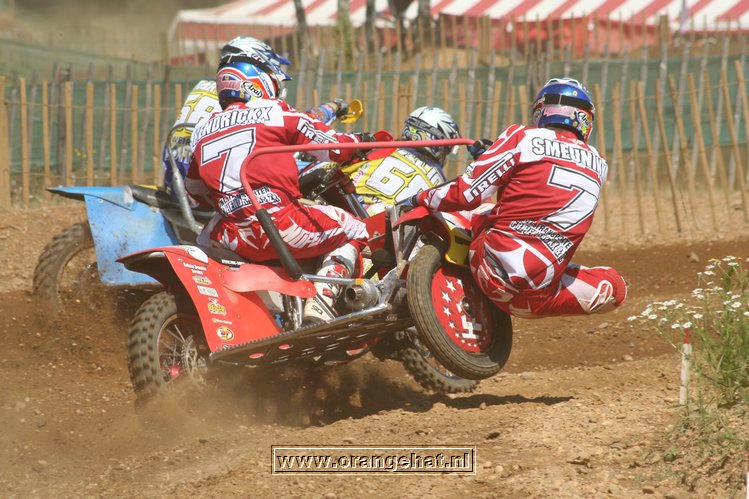|
Sidecarcross
is a sport where teams of two
men race motorcycles outfitted
with sidecars on an earthen track. The driver and passenger work together
in order to maneuver the motorcycle around the track's curves
and jumps.
It doesn’t matter if the sidecar is attached on the right or on the left
side of the actual motorcycle. In general sidecarcrews from countries
where the drive at the right-side of the road also riding a right-hander
and crews from England for example, where they drive on the left-side of
the road, are riding a left-hander.

The Englishman Brown (111) with a left-hander fighting
with the
Russian Rodionov brothers driving a right-hander
Sidecarcross
is very similar to regular motocross but with a different type of
motorcycle chassis, and with a team of two people riding together instead
of one. Sidecarcross is carried out in the same way as regular motocross
on the same tracks. Handling offcourse
is different due to the
sidecar.
The driver handles the bike a
bit similar to the way he does
in regular motocross races but the bike doesn’t lean on turns. And
that’s where the passenger comes into play and has
to deliver on the crucial task of moving his weight around in the sidecar to
ensure that the bike goes faster and does not flip over on
turns and jumps. In fact it’s the passenger who ends up doing more
physical activity in this sport than the driver. Hence it’s important
that the passenger is in the best physical condition possible before he
gets into the sidecar. One
of the most important aspects of sidecar racing is teamwork; the best
sidecar teams in the world developed a high level
of teamwork needed to be successful in the sport.

The passenger has to lean out of the
sidecar in some turns
to make sure the sidecar doesn't flip over
The official FIM World championship is held over several GP rounds at top
motocross venues throughout Europe. A sidecarcross GP takes two days. On
Saturday the qualifying and on suday the actual GP-races for the
championship points. At some of the GP’s the qualifying is actually a
‘real one’
because only thirthy
sidecarcrews can enter the GP on Sunday and most of the GP’s more then
thirty teams are signed in.
In that case the split all the sidecarcrews in two groups,
the ‘A’ and the ‘B’ group
according to the actual
world championship standings. The
leader goes to A-group, second team goes to the B-group, third team to A
etc.)
Both
goups have to race one heat to
be sure that they belong to the best thirty teams who can enter on sunday.
If a team doesn’t
make this, the GP weekend ends on Saturday.
On Sunday there are two GP-heats, duration 30 minutes + two rounds, where
sidecarcrews can earn points for the FIM World Championship Sidecarcross.
Other races, like national championships, are held on one day instead of
two.
The sport is very popular in Eastern and North-Western Europe. There is a
much smaller scene in North America and Australia. The most successful
sidecar-motocrosser in history is the Dutchman Daniël Willemsen, who has
become World Champion nine times so far as a driver. Other very succesfull
crews from the past where Sergis/Rasmanis from Latvia (6 times World
Champion) and two crews from Switserland both
becoming
World Champion 4 times; Bächthold/Füss
and Fuhrer/Kaiser.

Dutchman Daniël Willemsen (nr.1) overtakes the Latvian
team Sergis/Rasmanis
in front of the eyes of thousands of spectators during a GP
|
|
|

